Covid 9/8/22: Booster Boosting
post by Zvi · 2022-09-08T13:50:00.998Z · LW · GW · 9 commentsContents
Executive Summary The Numbers Predictions Deaths Cases Booster Boosting M.A.S.K at the A.E.A Physical World Modeling Conventional Wisdom Chutzpah In Other News Monkeypox Not Covid Bad News Good News, Everyone Reinforcement Learning From Human Feedback None 9 comments
Does it make sense to get the new updated booster? I give my (Not Medical Advice!) definitive take on how I would personally make the decision, and report the opinions of a number of other sources. Unless something changes, this is my take on that subject.
There’s also a variety of small things happening, both in the Covid section and later in the non-Covid section. I get to do two distinct little notes on gambling, and the FDA Delenda Est of the week is about the Food rather than the Drugs.
Executive Summary
- Updated boosters available, consider getting one.
- Still a lot of rather silly mask mandates, although no longer in NYC.
- A rather impressive (if not impactful) case of pure Chutzpah.
Let’s run the numbers.
The Numbers
Predictions
Prediction from last week (HOLIDAY): 420k deaths (-20%) and 2,550 deaths (-20%).
Results: 452k cases (-14%) and 2,728 deaths (-17%).
Prediction for next week: 490k cases (+9%) and 3,000 deaths (+10%).
This prediction is expecting some real improvement, but for it to be dominated by a larger reversion from a holiday weekend.
Deaths

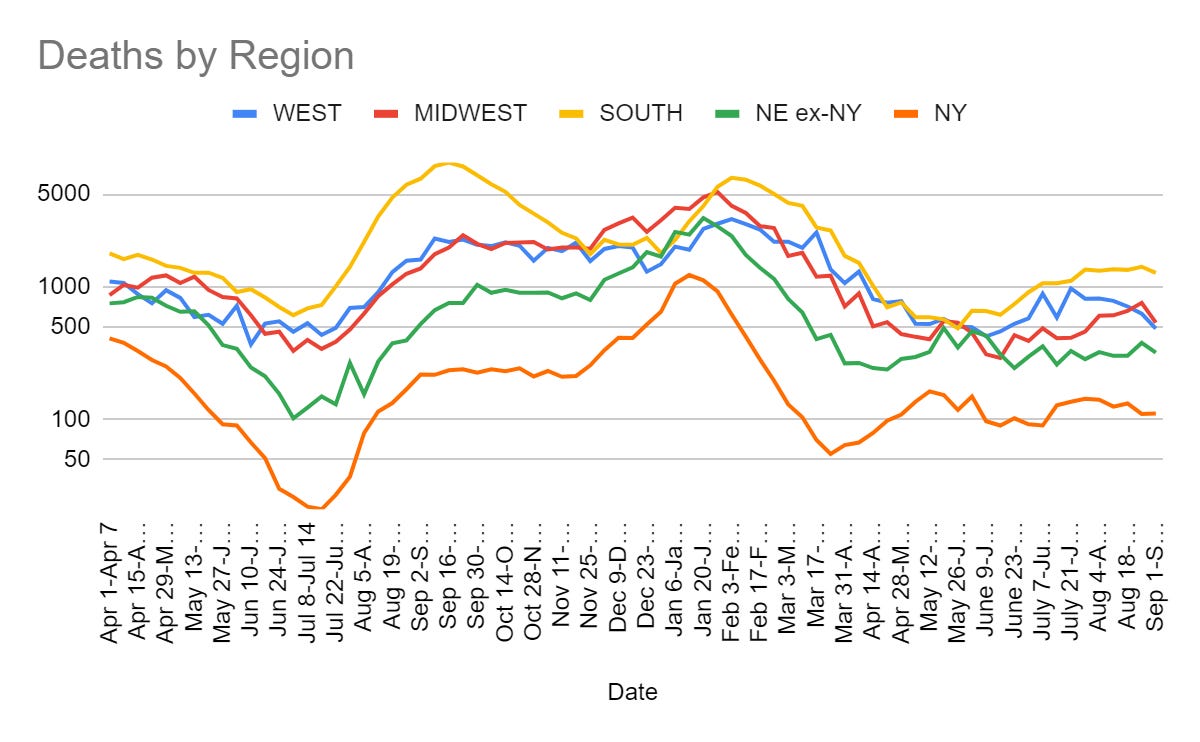
Cases

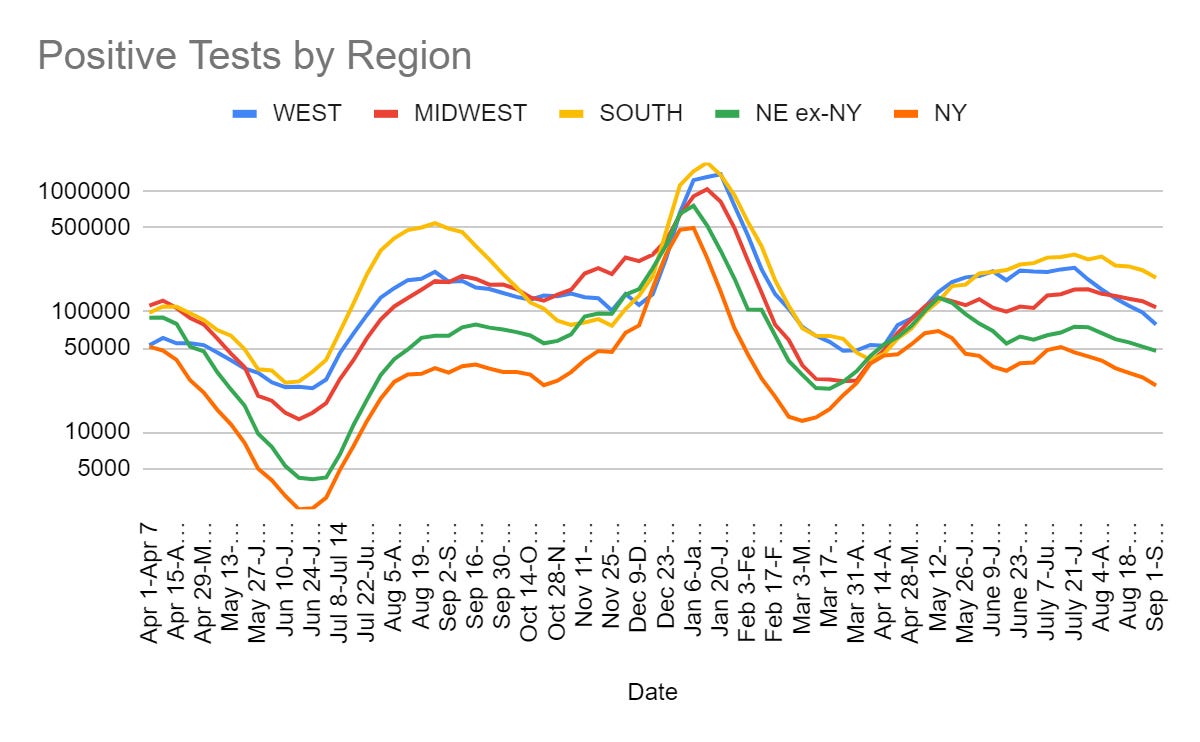
Booster Boosting
Public service announcement before the main discussion:

With that out of the way: To be as explicit as possible, while keeping in mind this is Not Medical Advice, I will give my full answer to how I personally for myself would answer ‘should I get the new updated booster when it becomes available?’
Essentially, I would get the booster if and only if I was already vaccinated, had not been infected or vaccinated/boosted within 6 months, and either (1) not yet had a first booster or (2) was at relatively high risk.
So essentially:
- If I had not yet been vaccinated (first 2 shots), I’d get vaccinated first.
- If I had been infected or vaccinated in the last 6 months, I’d wait.
- If I had been vaccinated at least 6 months ago, but not boosted, and not infected in the last 6 months to my knowledge, then yes, I’d get boosted.
- If I had already been vaccinated and boosted more than six months ago, and had not to my knowledge been infected in the past 6 months, and was in poor health or are over the age of 50 or so, yes I would get a second booster.
- If I had already been vaccinated and boosted more than six months ago, and had not to my knowledge been infected in the past 6 months, and was not in poor health or are over the age of 50 or so, probably no, but it would be a small mistake either way.
I would strictly prefer to get the new booster rather than the old booster.
I would consider it reasonable to attempt to ‘time’ the booster to match plans to visit vulnerable others and/or wait until a larger wave was coming. Note that if a large wave does come there is a good chance it will be a new strain.
White House says Americans will ‘only’ need yearly booster going forward. NPR offers a variety of takes on where the thresholds should be and whether to time things for a bigger wave. Celine Gounder suggests focusing on timing your booster to be 2-4 weeks before visiting vulnerable relatives if you are healthy, and splitting up the Covid and Flu shots if you can. Your Local Epidemiologist couldn’t be more excited to get hers, and has detailed thoughts on exactly how long to wait after various things.
My decision means I will officially not be ‘up to date’ on my booster. Neither will be (for a time) Dr. Fauci, despite his willingness to get a third booster.
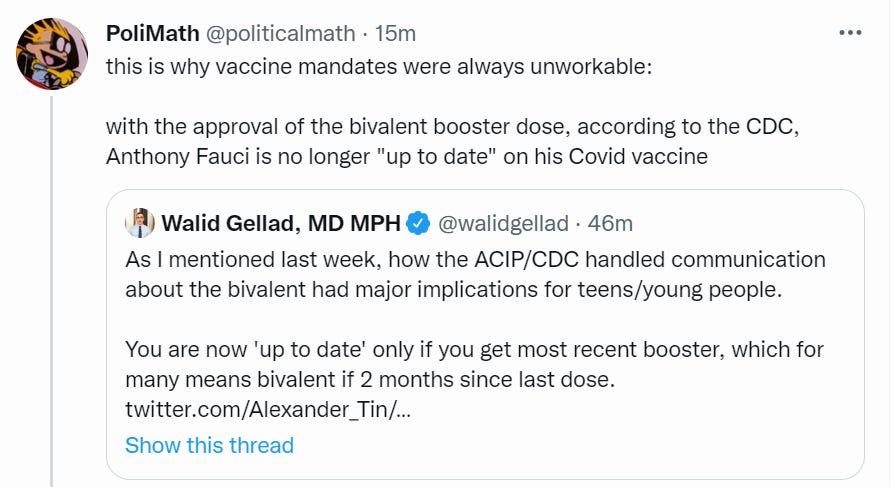
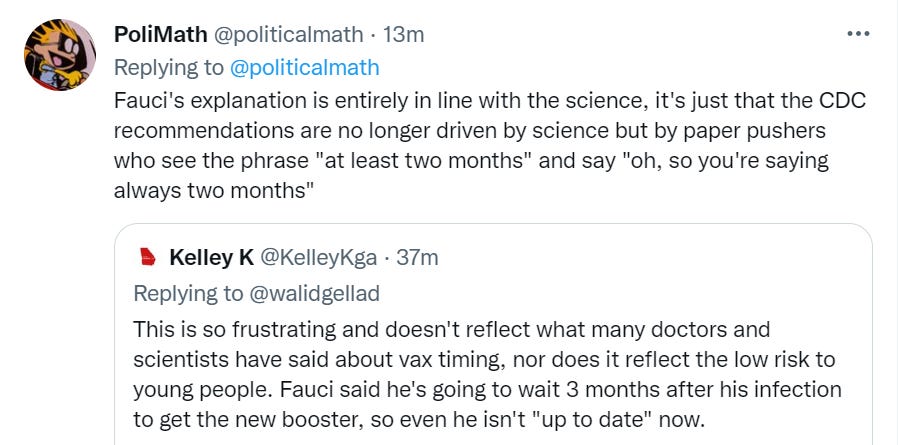
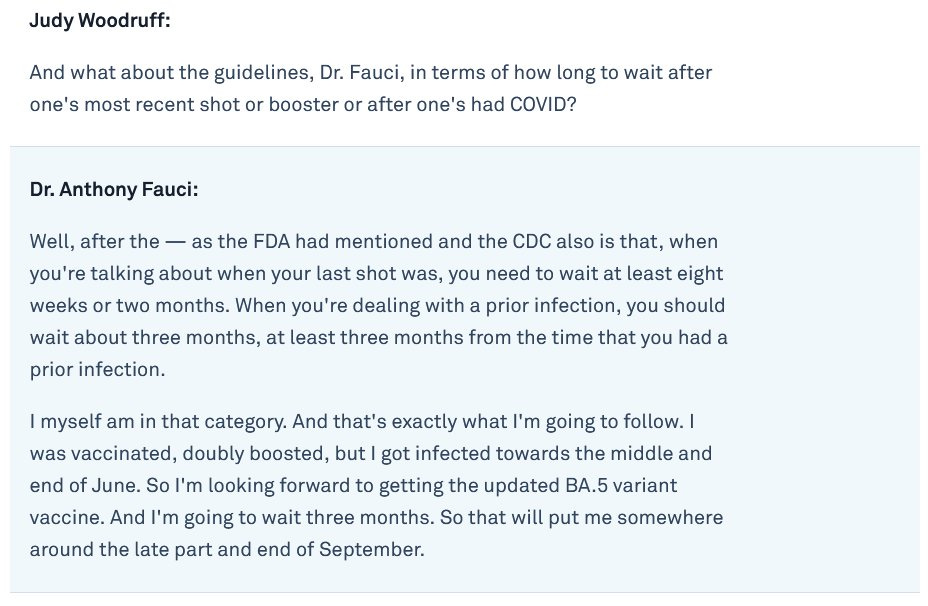

The question that matters here: What does it mean to be ‘up to date’?
If ‘up to date’ purely meant ‘has had all the boosters, all that one could possibly have’ as a supererogatory aspiration the way someone might say they are ‘up to date’ on the entire Marvel Cinematic Universe, then this definition is fine. You have, for now, watched all the movies and TV shows or had all the boosters. Congratulations?
To the extent ‘up to date’ here means ‘what it takes to be allowed to go to school’ or otherwise not be excluded from ordinary life activities, then we have an absurdist problem. Given only ~30% of the public is even boosted once, these worries focus on colleges and other places where social dynamics and signaling games force crazy public health (and other cultural) obsessions onto victims who don’t in practice have the choice of exit.
Speaking of which…
M.A.S.K at the A.E.A
Economists are often asked why they aren’t rich. The American Economic Association requiring masks and boosters at its conference suggests a simple answer. Those who cannot trade, teach.
What is actually in demand, and what is being supplied?
Yes, the new AEA regulations will mandate vaccine boosters for attendance at the New Orleans meetings. Not just two jabs but yes boosters, at least one of them.
Like the N-95 (or stronger) mask mandate, this seems off base and possibly harmful to public health as well.
Even they, it seems, are not crazy enough to require people’s boosters be ‘up to date.’
The bulk of that post is about the AEA’s booster mandate rather than the mask mandate, despite most people not having been boosted and the policy being extremely exclusionary to those seeking to attend the wide variety of available DEI seminars.
Is the problem primarily demand-side, or is it supply-side?
Tyler Cowen suggests having a vote of the membership, implying that the wrong customers are buying, and the problem is that management is not reflecting the preferences of shareholders, because management are the ones that solved for the equilibrium and members have no way to replace the board.
Such questions seem less and less focused upon by the AEA and its members. I see little evidence that either members or management care about non-symbolic outcomes here. Less of a mismatch, perhaps?
Here is one theory of the true costs and benefits.

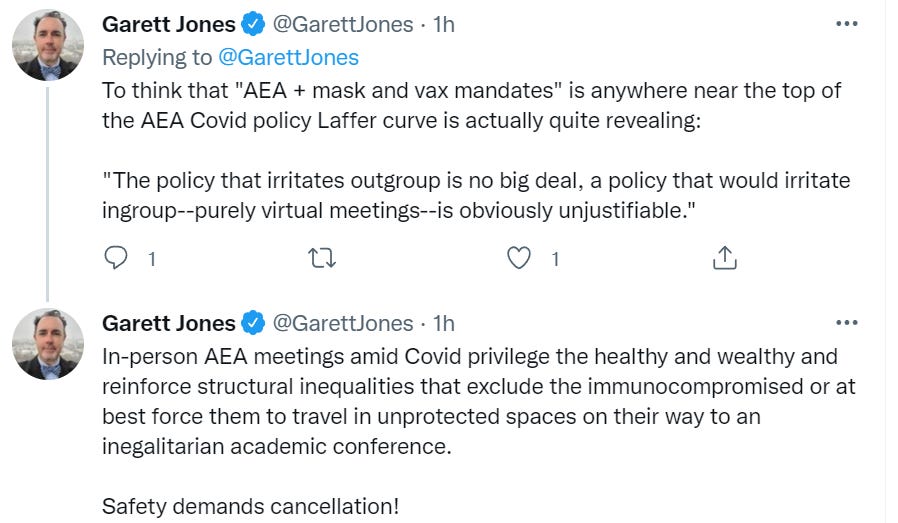
Nor is there any talk, as far as I have seen, of competing with the AEA. If the AEA is turning its back on economics, as the stories I read claim, yet they continue to enjoy their monopoly, that certainly reveals some preferences.
The whole thing reminds me of the story of the advocate of cost-benefit analysis, who, when asked why he wasn’t doing one, said “Never mind that, this is serious!”
Physical World Modeling
New York City lifts its mask mandates for mass transit, only months after everyone finished learning to ignore them. Disabled advocacy group expresses its dismay, instead advocating for Permanent Midnight because someone, somewhere is immunocompromised. Also complains that someone, somewhere has worn a mask improperly and implicitly demands the government fix this.
Head Start preschools are not as lucky, continuing to mandate masks for children as young as two despite CDC’s new guidelines. This is no small thing, it impacts a million children.

Yes, I do remember two weeks ago when the American Society of Pediatrics claimed there was no evidence of this.
Doctor’s offices are the place where mask mandates would make the most sense, because those masks arguably made sense before Covid to protect against other things. Reports are that masking has become far less universal at doctor’s offices. The link reflects the attitude where anyone in a mask is labeled ‘safe’ and anyone not ‘unsafe,’ if you are worried about two unmasked people at the doctors’ office (one of whom was behind a glass wall) then you should be more worried about
We are, in some cases, not doing a great job selling the updated vaccine.

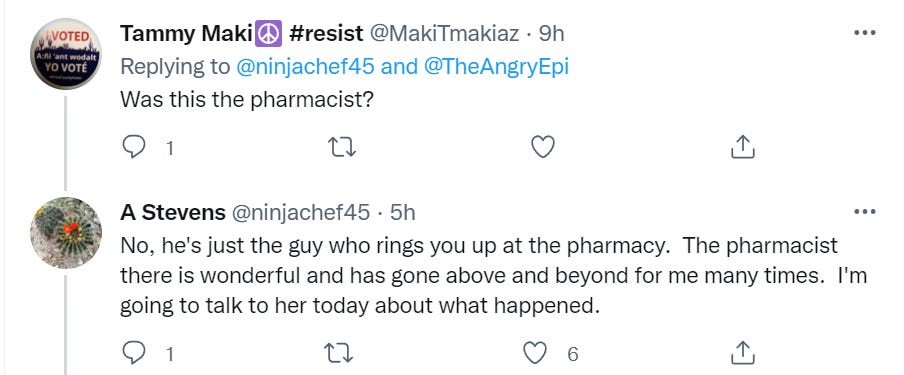
Of course, this isn’t exactly new…

ACIP also approved the new boosters, Weekend Reading has details. Also has some thoughts on a personal experience with Covid, and a look at the rebound statistics:
Unfortunately, I got a rebound infection. Ironically, on the day I tested positive with rebound, I was posting a tiny little meta-analysis of 2 papers on rebound probability with & without paxlovid.
Resulting calculations of rebound probabilities (and 95% confidence limits):
(1) With paxlovid: 0.83% (CL: 0.26% – 2.26%).
(2) Without paxlovid:: 1.15% (CL: 0.20% – 4.55%).
(3) Statistical significance: Given the overlap of the 95% confidence limits, you’d probably guess that’s not statistically significant. A test of proportion agrees, with a near-100% p-value.
Conclusion: We should call it COVID-19 rebound, not paxlovid rebound, because it seems to have little to do with paxlovid.
I find numbers like 1.15% highly unlikely given the number of anecdotal rebound. If I got Covid-19, what odds would you give me to bet on a rebound? Would you give me 10:1? 20:1? I very much doubt it.
Still, rebound was awful for me personally in terms of fatigue, lassitude, and brain fog. The brain fog still hasn’t lifted completely. Basically, COVID-19 didn’t hospitalize me or kill me, but it cost me about a month of my life (likely due to age). A second course of paxlovid would have avoided a lot of that, but my doc fell back on the “CDC says there’s no evidence” and would not be dislodged.
So I’m glad the FDA pushed Pfizer into a clinical trial for a second course of paxlovid, though I wish it had happened sooner for me personally. And, of course, it would be nice if they’d just test something simpler: start (almost) everybody with COVID-19 on 10 days of paxlovid and be done with it. Too many ways for the wrong decision to get made if you wait for a rebound to decide: patient doesn’t test, patient doesn’t report, doc not available, doc doesn’t want to write a second scrip, insurance says no, etc.
That does sound like a better solution. In general, it seems like there’s infinite Paxlovid and the barriers are purely that doctors hate giving out Paxlovid. It might turn out that the additional use has little value. I doubt a lot that it would have a big downside in such spots.
“I think business should start to normalize the work day” says Scott Gottlieb. Seems like a better time than waiting longer. Either you have a work day going forward or you don’t, it’s not like anything is going to improve much if you wait. He feels the need to cite the new booster and therapeutics and such, which help on the margin I suppose. We all need our fig leaves.
There are definitely bad times to get a booster. There is also a wrong approach to corporate social responsibility, a wrong way to make a planning list and a wrong way to eat a Reece’s. We say the opposite based on anticipated statement impact on the margin.


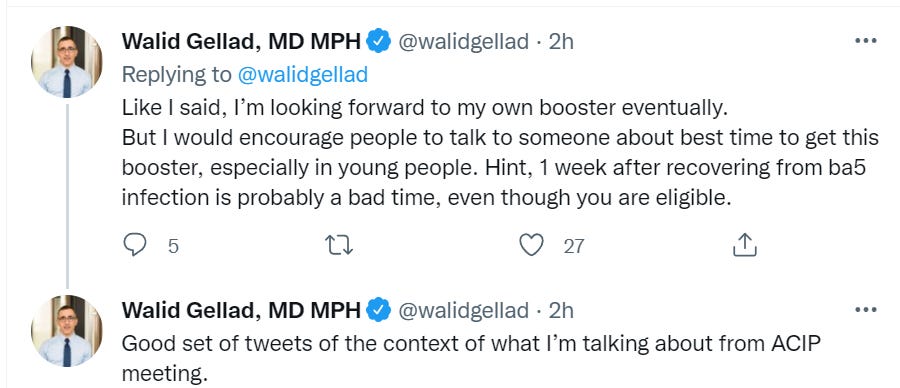
Conventional Wisdom
The New England Journal of Medicine asks:What is conventional wisdom?
How do you define conventional wisdom? (OP)

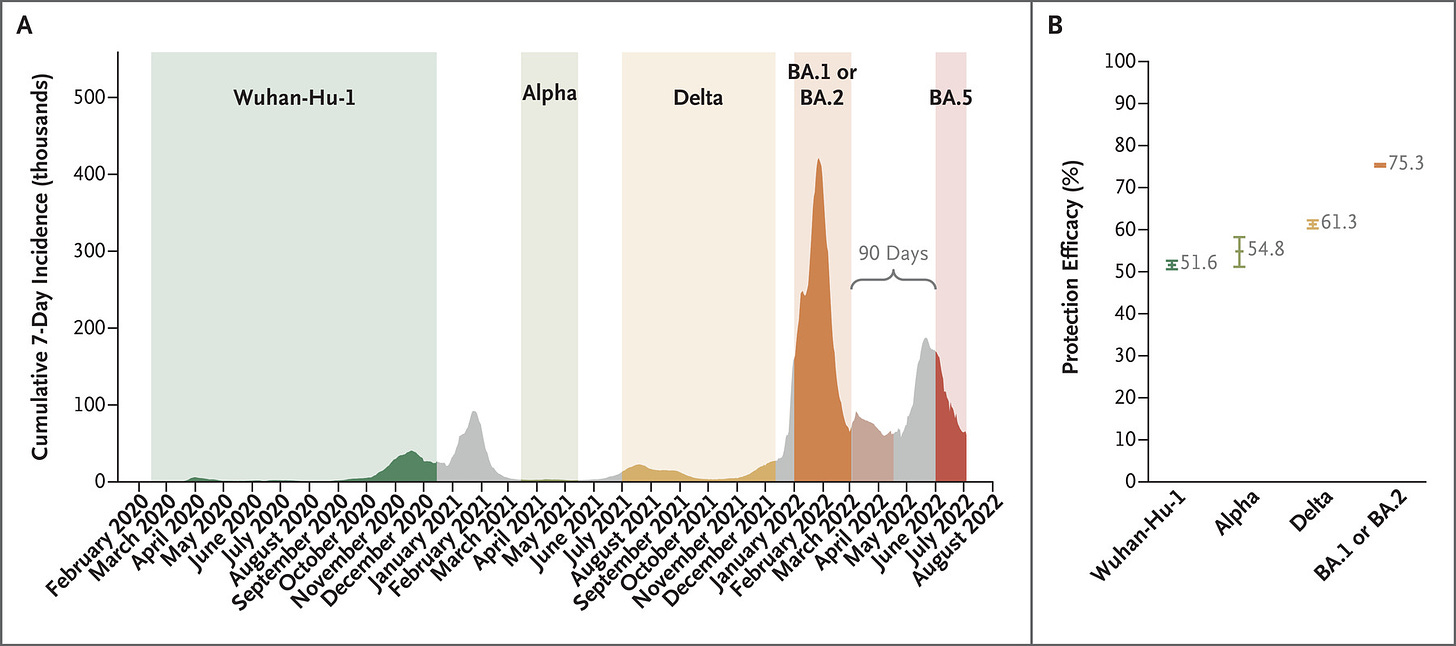
Claiming this is ‘conventional wisdom’ is Obvious Nonsense. We may have a new champion for use of the Law of No Evidence. Also, the graph tells us that non-Omicron strains were also found protective >50%. Given the origins of Omicron, a lot of the difference here is plausibly about time lapse rather than the strains themselves.
Zeynep Tufekci weighed in to confirm that no, this was never ‘conventional wisdom.’
Long Covid as an opportunity to finally do proper investigation of chronic illness. I am more skeptical of what was already been done, but I agree that if we did detailed studies sufficiently properly and in depth then this holds a lot of promise.
Hand waving at an analysis of a new paper on effectiveness of the vaccine in children. Paper finds good effectiveness at first but that it wanes a lot over not all that much time. I too am not going to read the paper in depth, and would caution to not take the point estimates too seriously. I do not think this changes much the calculus on whether to vaccinate children, even if you fully accept the result.
Chutzpah
Full context is important, so: Transcription is mine, apologies for any errors.
Washington Free Beacon @FreeBeaconJean-Pierre blames Trump for schools being closed during Covid and says schools re-opening “was the work of Democrats in spite of Republicans”
September 1st 2022102 Retweets349 Likes
Reporter: The National Assessment of Educational Progress has this new testing that shows that nine year olds lost ground in pretty dramatic fashion as a result of the pandemic. What is the President going to do about it? What is the Administration going to do about this severe learning loss? And does the Administration shoulder any blame for not pushing schools to reopen sooner?
Jean-Pierre, Press Secretary: So let’s step back to where we were not too long ago when this President stepped into this administration. How mismanaged the response to the pandemic was. How 47% of schools were in less than 6 months our schools went from 46% open to nearly all of them being open. That was the work of this President.
(0:56): And that was the work of Democrats in spite of Republicans not voting for the American Rescue Plan. Which $130 billion went to school to be able to have the ventilation, to have the tutoring, and the teachers and be able to hire more teachers. And that was because of the work this administration did. We were in a place where, again, schools were not open. The economy was shut down. Businesses were shut down. And what we have seen, we have seen the numbers but that’s what we see. That’s what we saw, it shows how mismanaged the pandemic was and the impact that pandemic had on the kids’ progress and academic well-being.
And so our priority remains to ensure that states and schools and districts are using these funds, $130 billion dollars, this is going to go again to tutoring, to more teachers. Real solutions. Real solutions to ensure that our kids are getting what they need. And you know every Republican Congress voted against that money. That is the reality. We have to do this on our own. And so we are going to ensure that those funds are directed towards the students who are, who will, who fell the furthest behind. Which is important and we must repair the damage.
The argument here seems to be:
- When Trump was in office many schools were closed.
- With Biden in office schools then opened.
- Democrats allocated $130 billion to schools in a bill Rs opposed.
- Therefore, schools (and businesses) were opened in spite of Republicans.
Which seems to have rubbed some people ever so slightly the wrong way.
There are four importantly correct ways to respond to this situation.
The first is to admire her chutzpah and her attempt to do DARVO.
The basic facts are these:
- Trump and most Republicans wanted to open more things faster.
- Biden and most Democrats wanted to open less things slower.
- This included businesses, schools and other things.
- Where Rs were in charge, more things were open faster.
- Where Ds were in charge, less things were open slower.
- This included schools. Night and day differences.
- This was the subject of many vicious attacks all around.
- We know now that the Rs were right about opening schools faster.
- We had the information to know at the time. This wasn’t that hard.
- Voters are very not happy that schools were kept closed.
- Additional funding did not change reopening timing much.
- Air filtration was never a true objection to almost any schools reopening.
- Air filtration still mostly isn’t happening, but urgently should happen.
- The biggest impact on reopening timelines was Operation Warp Speed.
Jean-Pierre is attempting to imply that Biden should get credit for schools reopening, because half of it happened on his watch and after Democrats authorized the school-related spending of money. Whereas if Trump had his way or local Republicans were in charge, most schools would have been open in September 2020, while Democrats screamed about how many kids and others this would kill.
So, yeah. No.
However, Jean-Pierre is good at her job, which includes avoiding saying that which is not.
“And that was the work of the President” is certainly pushing it, but it is narrowly defined to apply to the later time period and one could reasonably argue by that point that Biden did work to reopen more schools faster. Republicans didn’t vote for ARP, which had the effects she described given that she didn’t claim any magnitudes or numbers other than the money. The “this” they are doing on their own is spending that money. And so on.
So that’s the second note. She implied, tried to start a narrative. She did not quite lie.
(She does occasionally say things that are not, such as that Biden created ten thousand million jobs, but we all misspeak every now and then.)
The third note is that this reveals a lot about how Very Serious People often think.
They do and think things like:
- Make lots of rules that ban or heavily restrict X.
- You know, for safety.
- Amount of X goes down.
- Not their fault.
- Decide X is good, actually.
- Pass a bill that spends money in the name of X.
- Maybe, maybe, take back some of the rules against X.
- Forget that they made all those rules in the first place.
- Amount of X goes up, and is now down less.
- Take credit.
In this mindset, the way that you accomplish things is you spend public money and otherwise burn resources. They then brag about how many resources were spent.
Spending resources is not a benefit. Spending resources is a cost.
Spending money is not a benefit. Spending money is a cost.
More people working on the problem is not a benefit. It is a cost.
More hours devoted to the problem is not a benefit. It is a cost.
More time spent in college is not a benefit. It is a cost.
More vaccinations or medical care is not a benefit. It is a cost.
These things can of course be very good costs to be spending if they result in benefits.
Sometimes they do. If the medical care makes you healthy and the college gives you useful knowledge and the work solved the problem, that’s great.
Often they do not do this. Or, there is a much lower-cost way. Do that instead.
Usually the lower-cost way that would work better is ‘stop restricting X.’
That’s not how this kind of thinking works.
This kind of thinking is that what is praiseworthy is the Sacrifice to the Gods. Problems are solved by the destruction of resources.
The fourth and final way to respond is to be grateful that everyone agrees it was important not to shut down schools and to reopen them as fast as possible. That is great. It means that future school closings are less likely, both for Covid-19 and otherwise.
Also, before I move on: A word of encouragement to everyone out there who think they’re not good enough or have imposter syndrome. If you think you are not up to public speaking and would only embarrass yourself, or are thinking similarly about anything else, consider whether you are holding yourself to a reasonable standard. This was the Press Secretary of the United States. Top job in the field. On a technical level, which is totally not why this clip was shared around, this response was totally normal and fine. That’s even though the transcript above removes a bunch of copies of ‘uh’ and various stuttering and such, and all the little things I chose not to correct. On a strategic level, was this a good or bad idea? Good question. Everyone, everywhere, is muddling through. You can too. No one is C.J. Craig. Comparing yourself to her is like comparing your life to the feed of an Instagram model.
And a reminder not to condemn all ‘remote learning’ based on what we did during the pandemic.
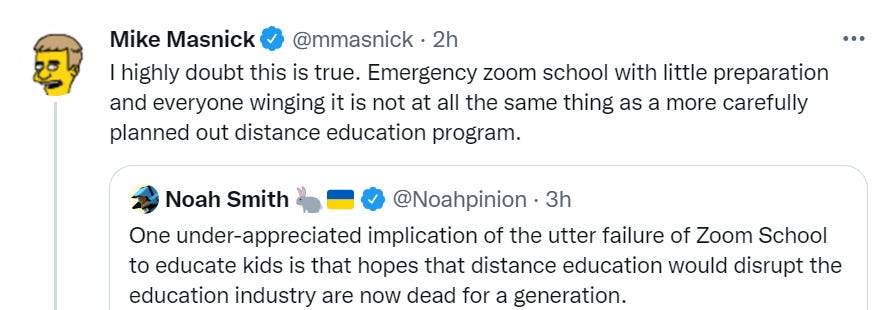
What we did during the pandemic was a dystopian facsimile of in-person schooling designed to ensure no child avoided any suffering and all boxes were checked.
The future of home schooling and remote education is to do better. As opposed to the pandemic implementation, whose goal was to avoid doing better.
Boxes must be checked, you see.

In Other News
No more free antigen tests through USPS.
High correlation between lack of health care access and being unconvinced by vaccination?
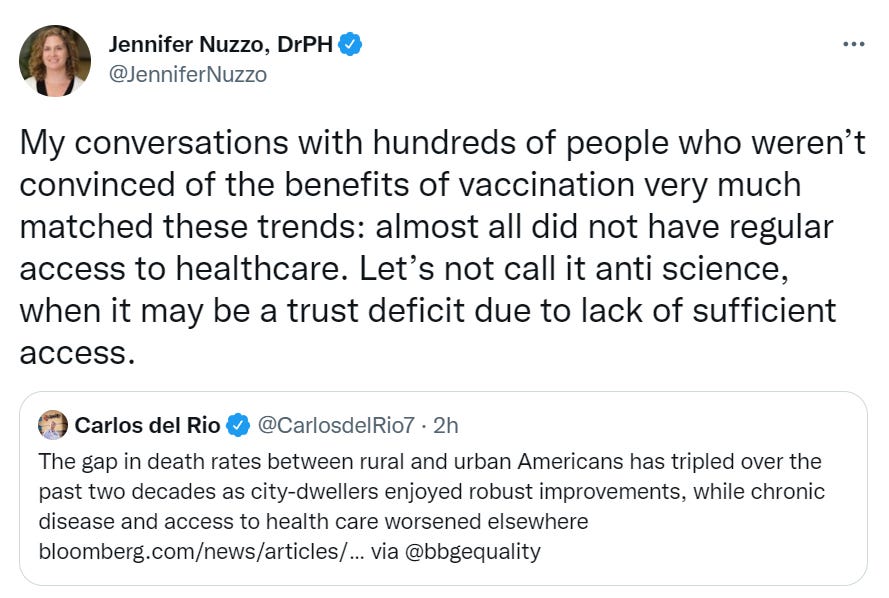
The two obvious problems with this hypothesis are, one that way more people doubt vaccines than lack regular access to health care:
The percentage of people with health insurance coverage for all or part of 2020 was 91.4. In 2020, private health insurance coverage continued to be more prevalent than public coverage at 66.5 percent and 34.8 percent, respectively.
…
Percent of persons with a usual place to go for medical care: 88.6%.
And two, there is a huge partisan divide in vaccine trust, which isn’t echoed in healthcare access.
Monkeypox
Graphs that raise a lot of questions already answered by the graph.
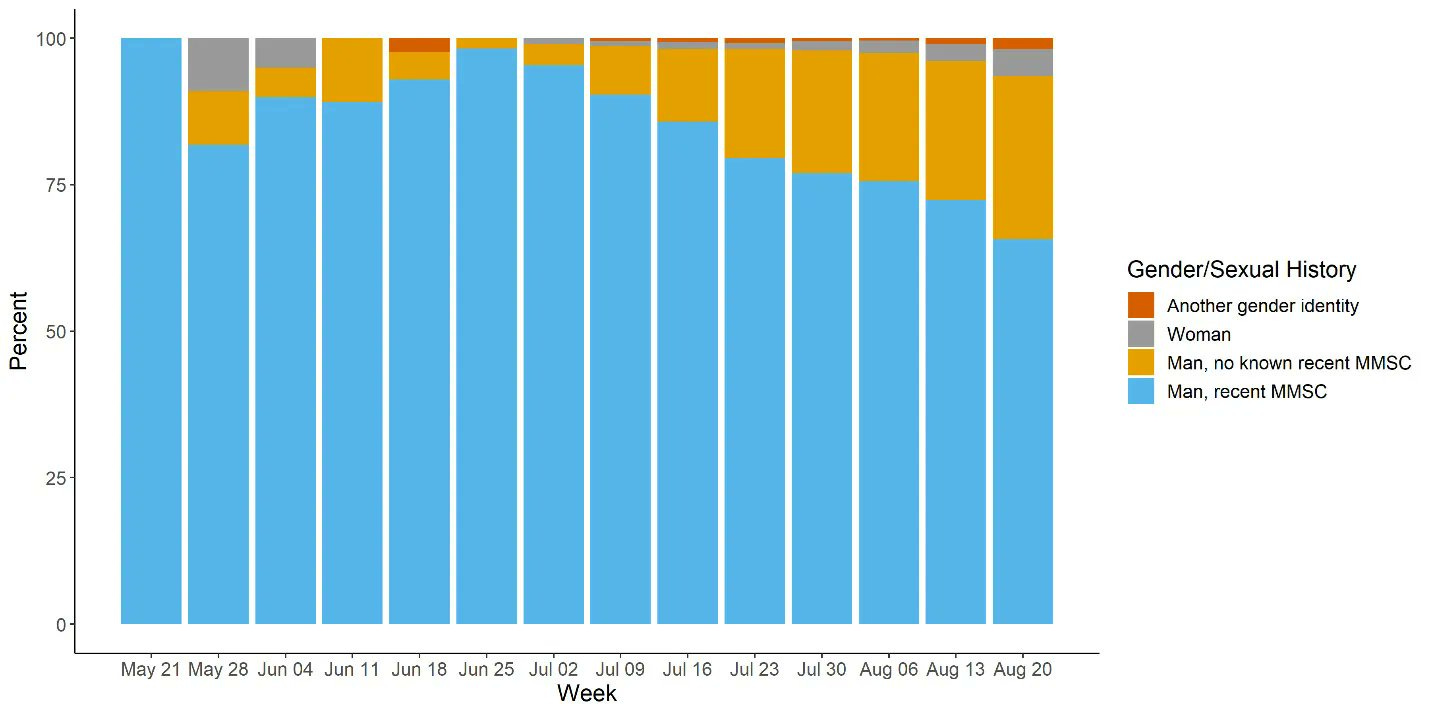
The blue bar is getting smaller, and the uptick that last week in the number of women is indeed not a great sign although it could also reflect less MSM transmission and thus be a sign of something good. Caitlin’s theory for what’s happening is that case finding has improved. I might modify that a bit to say that you no longer need to be seen as MSM in order to have hope your case might be identified. This results in a larger share of positive folks not admitting to being MSM (which, given the medical system, seems very reasonable), and also an uptick in percentage of women, which could also be the result of less MSM spread after behavioral changes, so it would be a sign of good things.
Cumulative case growth as of the weekend:
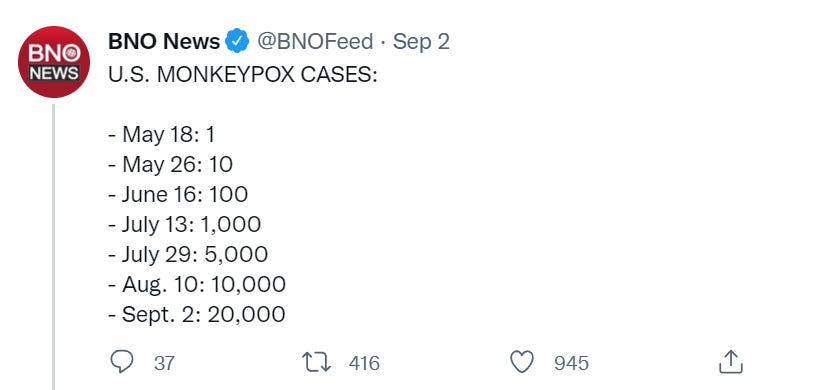
In exponential terms this is excellent. The last doubling took 23 days. The previous one took 12. Before that we went 5x in 16 days.
In linear terms this is also excellent. 5,000 cases took 12 days, then 10,000 cases took 23 days. Almost zero increase. We’re good.
Here’s a CDC report with a lot of detailed info, if you want it.
Not Covid
An environmentalist gets lunch: ‘Why being an effective environmentalist can often feel like being a bad one.”
The reason given here is that the things that feel environmentally friendly, and the things advocated for by environmentalists, tend to not be the things that help.
Yet it still feels wrong. I know I’m doing the right thing for the environment, but there’s still a part of me that feels like a traitor. I can see the confusion on peoples’ faces when they hear about some of my decisions. I feel embarrassed that people might think that I’m being a ‘bad’ environmentalist.
…
This misfire doesn’t stop with food. A plastic bag seems a lot worse than a paper one. In fact, it’s the opposite.
…
A wooden stove seems more eco-friendly than a gas heater. Many think that coal is a better option than nuclear energy, despite the latter emitting much less CO2, and being thousands of times safer. Living in the countryside seems much better than living in a city. There are few places I feel less ‘green’ than when I’m crammed against the door of the London tube. Driving to a cottage in the hills for the weekend seems infinitely more sustainable. But it’s not: dense cities are good for the climate – we can use economies of scale to reduce emissions from transport, services, and if we’re lucky we can even share heating with our neighbours.
This is her explanation:
Why, then, do we often get this so wrong? It probably comes back to the ‘natural fallacy’: things that seem more grounded in ‘natural’ properties seem better to us. Or our ‘appeal to nature’, where natural equals good, and unnatural equals bad. We’re skeptical of synthetic stuff that comes out of a factory.
There is no question this is a large part of the story.
What the post misses is that people are not looking for efficient, effective solutions.
Oh, no.
Remember Covid prevention. This isn’t different.
People are looking to make Sacrifices to the Gods. People mostly want to inflict pain on themselves and others in the name of environmentalism. To do conspicuous non-consumption. The more conspicuous, the better.
As an example, single use plastic grocery bags are more environmentally friendly than the alternatives, and it isn’t remotely close.
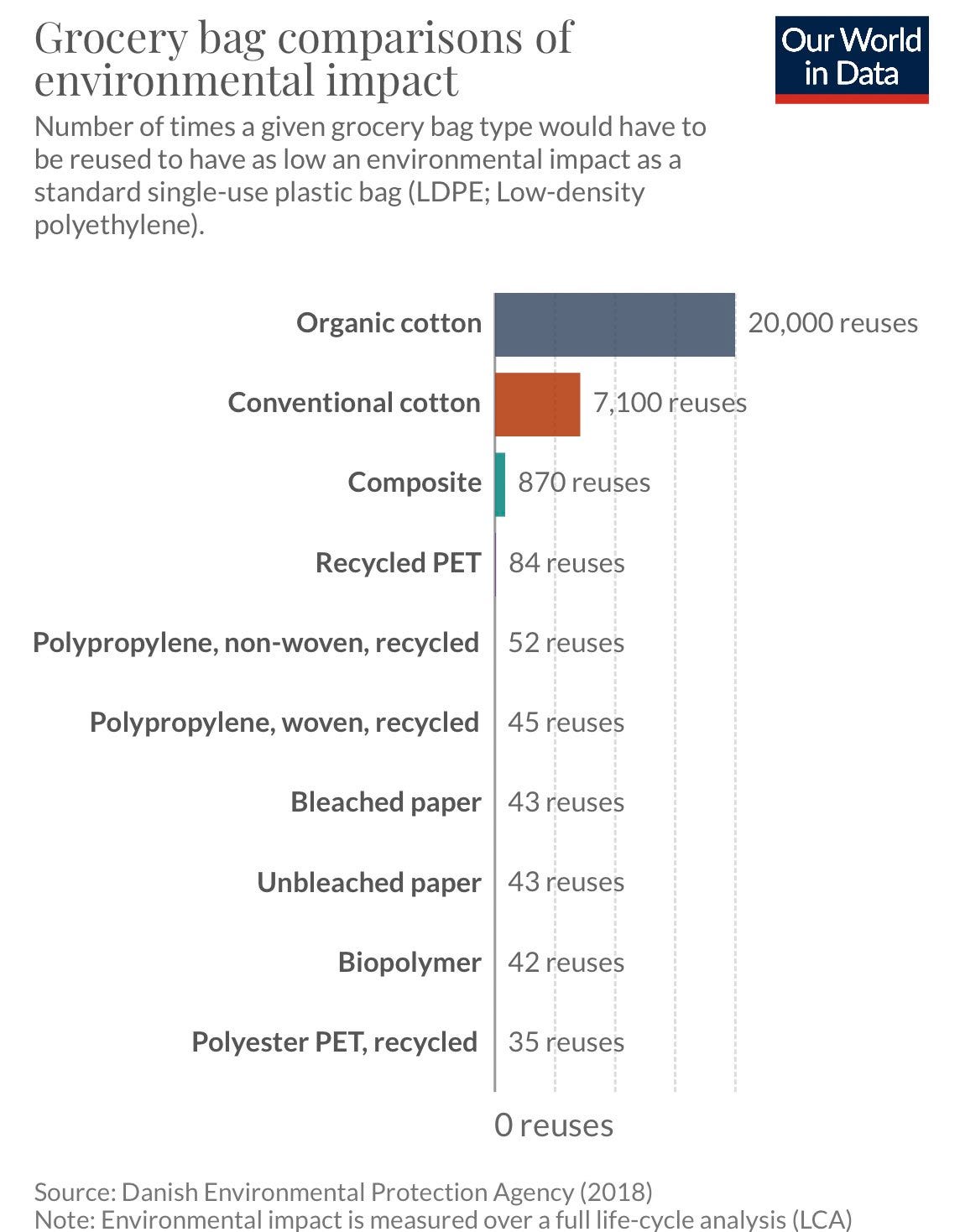
What percentage of advocates for the bans on such plastic bag would, upon learning this, reverse their position?
Thus, this is importantly reversed:
Part of the motivation for living more sustainably is feeling like you’re doing your bit. If what we ‘need’ to do is at-odds with what feels right, then that’s a problem.
…
It’s only then – when the image of ‘environmentally-friendly’ behaviors line up with the effective ones – that being a good environmentalist might stop feeling so bad.
Being a ‘good environmentalist’ does feel good to many people. That is because it very much is not a synonym for ‘someone who helps the environment.’ What we ‘need’ is at odds with what ‘feels right’ and that gives the opportunity to sacrifice ‘needs’ and feel good about doing it and making other people do it.
If it was an efficient action that needed to be done, it wouldn’t do this, the same way that a Covid precaution that actually worked and was worth doing wouldn’t scratch the necessary itches. Thus, when I look at the correlation between ‘things people think of as environmentalist’ and ‘things that help improve the environment and mitigate climate change’ I am genuinely unsure of the sign of the correlation. On the current margin, it seems to be negative. Green energy is an especially stark case here.
Ranked choice voting is in the news, as it gives the Democrats (presumably highly temporary) control of Alaska’s house seat due to some weird dynamics. That means that this week Team Blue loves ranked choice voting and Team Red hates ranked choice voting. I fear this is a setback for the practice. It raises so many red flags.

I notice that a remarkably large number of traditional American elections were ‘close to electing one of two very opposite candidates.’ Quite the red flag, there. Which OP would actually endorse, suggesting Approval Voting instead as unlikely to have the same problem. I expect all three methods to have the same problem, with both Approval and Ranked having it less than current methods, especially once the system adjusts.
How much sampling bias here, do we think?
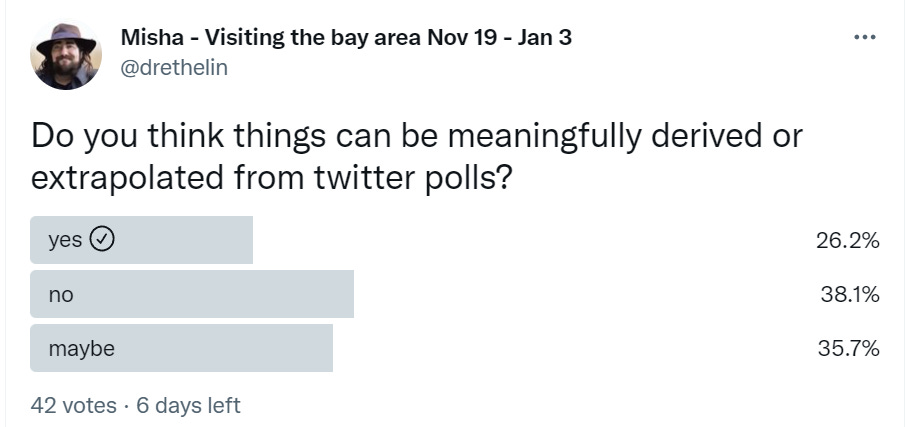
How much sampling bias here, do we think? (study)
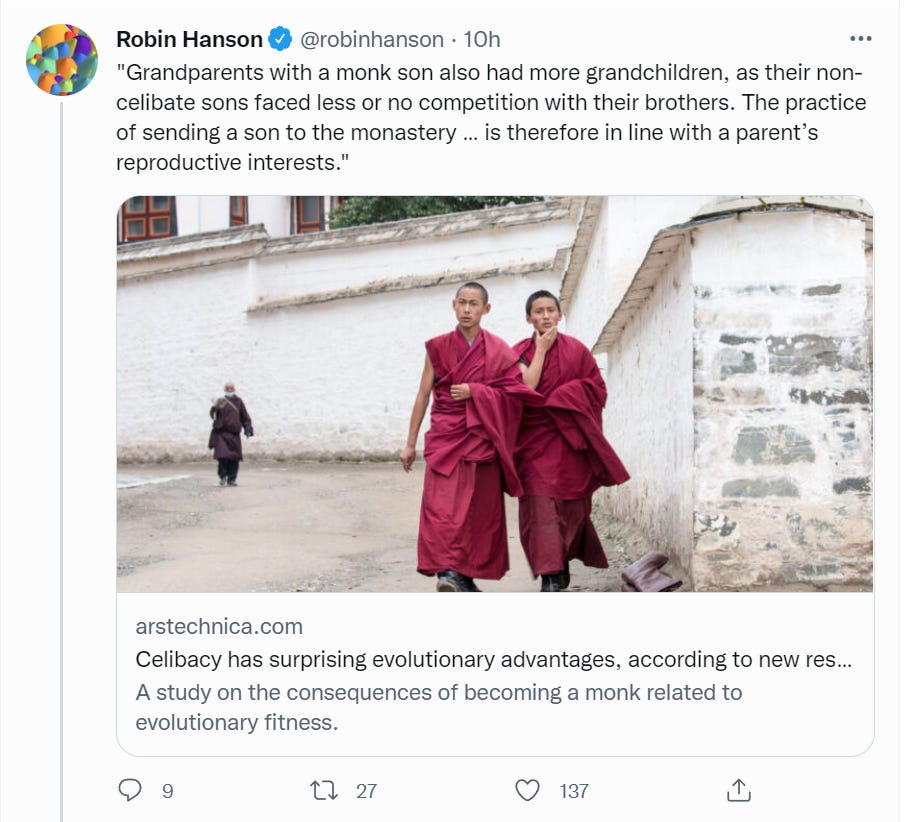
The effects found were large, only in brothers of monks and not in sisters.. Results are broadly consistent with wealth and reputational effects, except that magnitude is still bizarrely high, large enough to make the calculation close. It still does seem like from a purely reproductive perspective, if there are no hidden selection effects, those with only two sons who do this are still making a mistake.
Best selling fast-casual food chains in the USA, list and category both are weird.
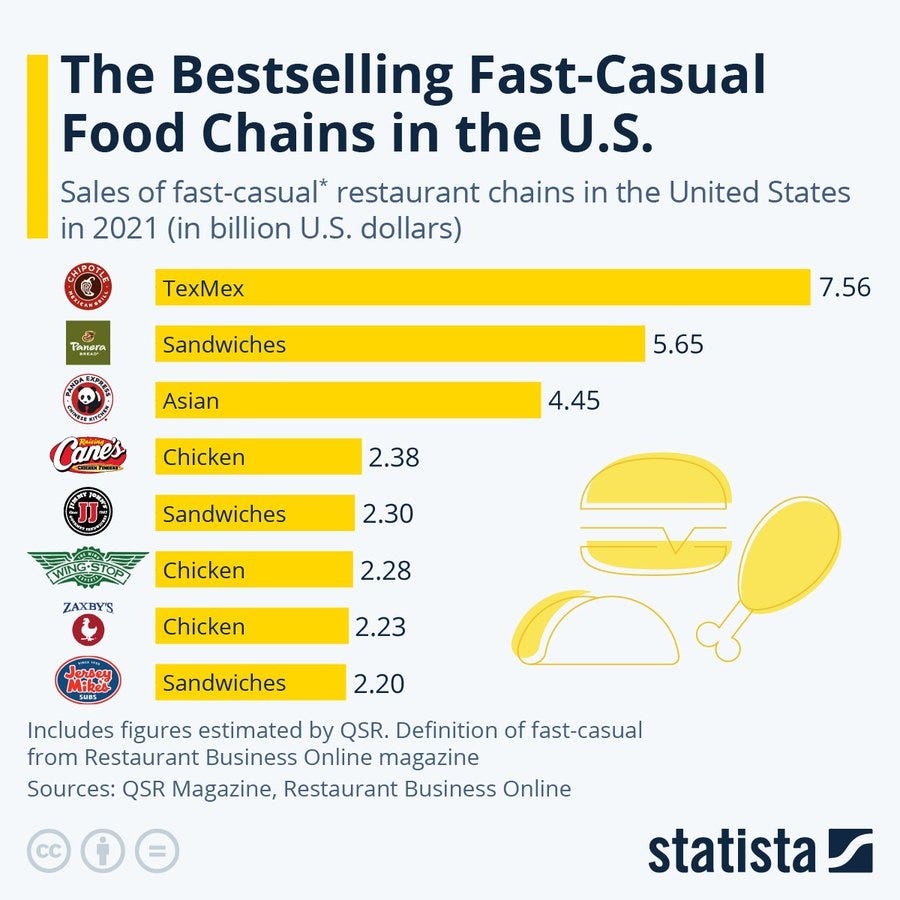
This does not seem all that efficient. If Chipotle is this dominant where is the competition? It is not as if they have a moat, and locally Dos Torros is by all accounts a strictly superior implementation of the format. Similarly, Panda Express does not seem substantially superior to other fast-casual Chinese implementations.
Also, the category definition is doing work here, such as Subway coming in at 9.4 billion, which would put it solidly first. ‘Make me a sandwich’ is ever-popular. For scale, McDonald’s is 23.2 billion.
Whenever anyone writes a think piece about sports betting, it is best to ignore the mood affectation (this one is against it) and look at the details.
The Arizona Mirror reported in May that, over the preceding six months, $2.8 billion in bets had been made in the state, bringing $225 million in earnings to sports teams and gambling dens, and $8.5 million into the state’s coffers. And in this age of stratification, $8 million dollars is pretty much nothing.
That last statement is dramatic. New York State is taking a 51% cut. That is offensively high, whether or not you think offensively is the correct amount of high to be here. Arizona it seems is taking only 4% of profits, which is offensively low. I pay 8% in state income tax. Seems odd to not ask for at least a 10% tithe here.
(I have zero idea why the next line points out how many households have $10 million in net worth, which is one of the oddest juxtapositions I’ve seen in a while.)
The more interesting ratio is the other one. On $2.8 billion in bets, there were net earnings of $225 million. That’s 8% profit (‘hold’) on wagers even if this is before expenses, which matches what aggressive online bookmakers can make when they target recreational players with intentionally distorted offerings.
This is where it is helpful to notice that on a traditional gambling line (-110 odds, 11 to win 10) a gambler who chooses at random would only lose 5%. The sportsbooks are doing some combination of luring gamblers into betting live or otherwise on odds that are even worse than this, or it is getting them to bet mostly on losing sides, or both.
Whenever I look at the odds listed onscreen during a Mets game, I want to sternly talk to whoever thought the prices involved were reasonable. When I see the in-game odds they display, it’s a mix of ‘give me the other side of that, that’s ridiculous, oh wait you didn’t show the other side of that, did you? Because it would be an utter disgrace if someone saw both prices at once.’ Or basically:

It is, once again, not that we sold out to the sportsbooks. That could be fine. I do think sports and gambling are complements, sports betting is fun and useful and if you object we should have a word about the terms of state lotteries. It is that we sold out to sportsbooks in a way that locked out real competition on price.
Give me the opportunity (as in, the legal right to do it) and I would obliterate these prices and grow Silicon Valley hockey stick graph style via word of mouth. Cutting prices by 50% is easy.
The trick is that with enough market share and skill, you can cut them by 100% and still win (probably 100% up to some amount like $10k per account, then 80%-90% after, you do still have to guard against market manipulation).
If you don’t think that’s true, ask how gamblers lose 8% in a situation where someone betting at random would lose 5%.
Another fun and informative Patrick McKenzie thread that explains a lot (his link).
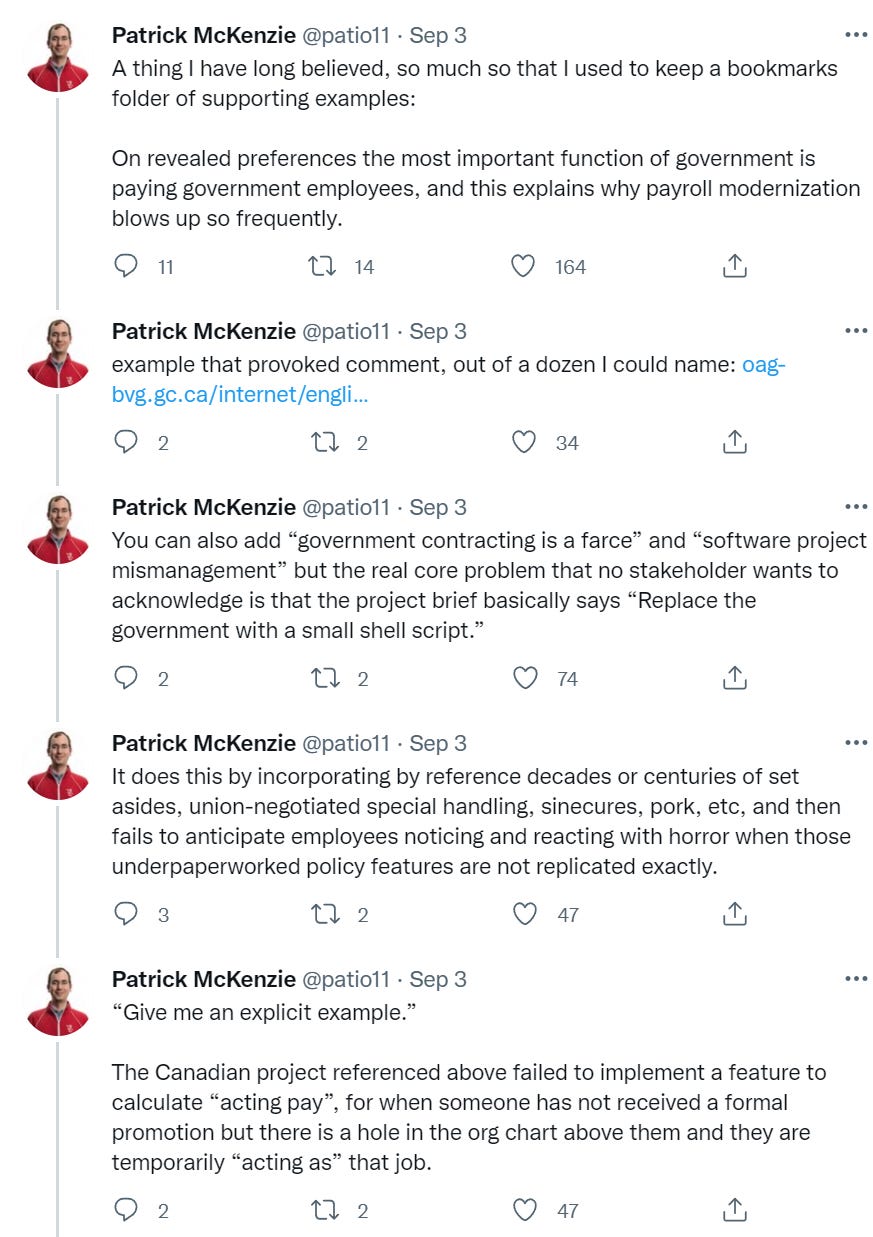

Also from him, the optimal amount of fraud is not zero. There is an interesting division between the areas where it is fascinating there is so little fraud (e.g. in credit card purchases) versus areas why it is fascinating that there is so much fraud (e.g. moral mazes). Also the areas where it is both depending on how you look at it (e.g. dating).
My theory on the optimal amount of fraud is that if anything we are below the optimal level of explicit and direct fraud (and theft), but we are far above the optimal level of implicit and indirect fraud and theft. We should treat them more similarly.
Bad News
It’s not only me, right (OP)? This (somehow popular) opinion is completely insane?
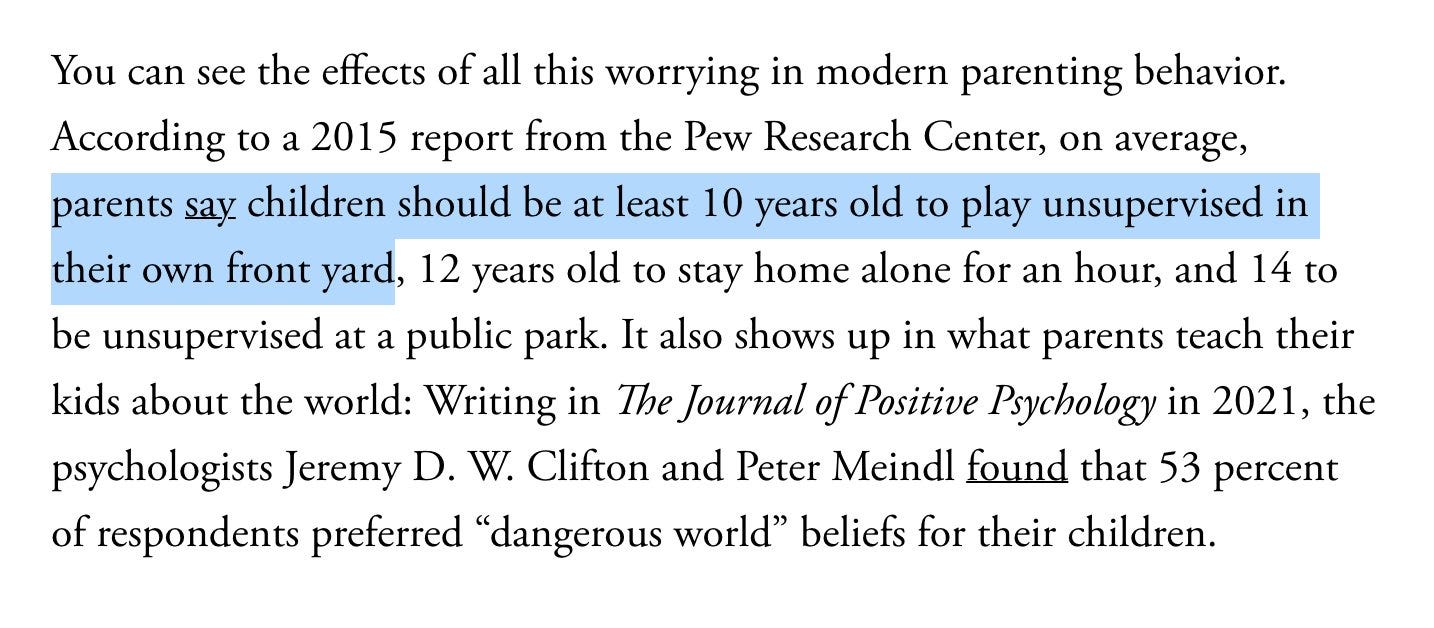
The OP’s bigger message is that the world is mostly safe. Teaching children that the world is unsafe is bad for them. It makes them less happy, less healthy, more fearful, more bigoted. Raising children while being obsessed with safety teaches children that the world is unsafe, and is additionally quite bad for them in other ways by denying them a childhood and the opportunity to play, learn, experience, get used to adversity and responsibility, and so on. As a reminder, children are dramatically safer today than ever before.
Since 1935, the number of childhood deaths between the ages of 1 and 4 fell from 450 to 30 per 100,000. It has fallen by nearly half just since 1990, and the decreases in other age groups are similarly impressive. Use this knowledge to counteract the media’s relentless focus on fear and danger.
The obvious counter to that is well yes everyone is obsessed with safety and this is keeping kids safe, which is good. I can’t prove right now that this is not true and that safety obsession buys you very little real safety in 2022. I do strongly believe it, and the dangers from the things safety obsessions are mostly about are trivially small risks and always have been. Kidnapping by strangers, in particular, is vanishingly rare, and without that danger why in the world would you need to be 10 years old to play in your own front yard?
I wrote specifically about the problem of car seats. I want to flag once again that this was mostly an example, the problem goes much deeper and it is killing us.
Las Vegas demolishes homes built by a charity on private property to house homelessness, because they are only 50 square feet. So, 0 square feet, then.
California commission unanimously rejects proposal to build a water treatment plant because the water would be ‘too costly for low-income customers.’ A fun game is trying to reconcile this with ‘we sell water at subsidized prices to all customers at all times’ and also ‘most of the water we use goes to agriculture for basically no money.’

The California port situation is so bad that some companies are shipping into the (automated) port of Virginia and shipped cross country over rail. Meanwhile our latest port improvement law has an explicit prohibition on using the money on automation.
Reminder: Never let the TSA get its hands on anything you need to protect.
A high quality spoiler-free review for a show I have not yet watched.
DC continues to go forward with child care regulations so obnoxious and expensive the Washington Post describes the situation as “Young families and many child-care workers were dealt a huge blow last month when a court upheld a pernicious D.C. day-care regulation.”
Putting legalities aside, the rule has always been truly dreadful economics. D.C. already has the highest-priced child care nationwide, with full-time center-based care for infants costing an average of $24,378 per year and even home-based care costing $18,425.
These figures amount to 79 percent and 60 percent of local median income for single parents, respectively, making child care simply unaffordable for the poorest, absent government support. Putting two kids into a child-care center in D.C. costs 41 percent more than the local average mortgage payment and nearly twice the cost of tuition at a public university.
Enforcing a new standard that requires carers to have an associate’s degree in early-childhood education or 24 credit hours in that subject to supplement an existing degree will squeeze the number of carers further, raising prices higher still.
The whole article has a large ‘yes, agreed, now do every other profession’ feeling.
As opposed to positions like this explicitly taken by a court:
In the ruling dismissing the appeal of the farmers, the courts agreed with the claims of the FDA and the Department of Health and Human Services that, among other things, “There Is No Generalized Right to Bodily and Physical Health,” writing in support of this claim that “Plaintiffs’ assertion of a ‘fundamental right to their own bodily and physical health, which includes what foods they do and do not choose to consume for themselves and their families’ is similarly unavailing because plaintiffs do not have a fundamental right to obtain any food they wish.” The court also agreed that “There is no fundamental right to freedom of contract.”
no, Plaintiffs do not have a fundamental right to own and use a dairy cow or a dairy herd;
no, Plaintiffs do not have a fundamental right to consume the milk from their own cow;
no, Plaintiffs do not have a fundamental right to produce and consume the foods of their choice.
They said “There Is No Generalized Right to Bodily and Physical Health.” On purpose. In a legal briefing. Which was accepted.
FDA Delenda Est.
They probably aren’t even letting almond milk and soy milk sellers call themselves milk anymore. While they should not (and, arguably, don’t) have this power and they doubtless have better uses of their time (although monkey’s paw curling could be involved there), I do have to admit that sometimes their hearts are in the right place.
Also, I propose the following amendment to the constitution, Amendment 28: “The rights of the people to freedom of contract and freedom of transaction shall not be infringed.”
Question I have not seen asked: Is it a coincidence that Jackson, Mississippi, the place currently having a water crisis also has the highest murder rate in the country? In addition to common cause explanations, I would do extensive testing on that water.
I worry a tiny about someone noticing this and doing it, but then they might be more interested in noticing things in general, which would matter more. In the meantime, why are there twenty dollar bills all over this sidewalk?
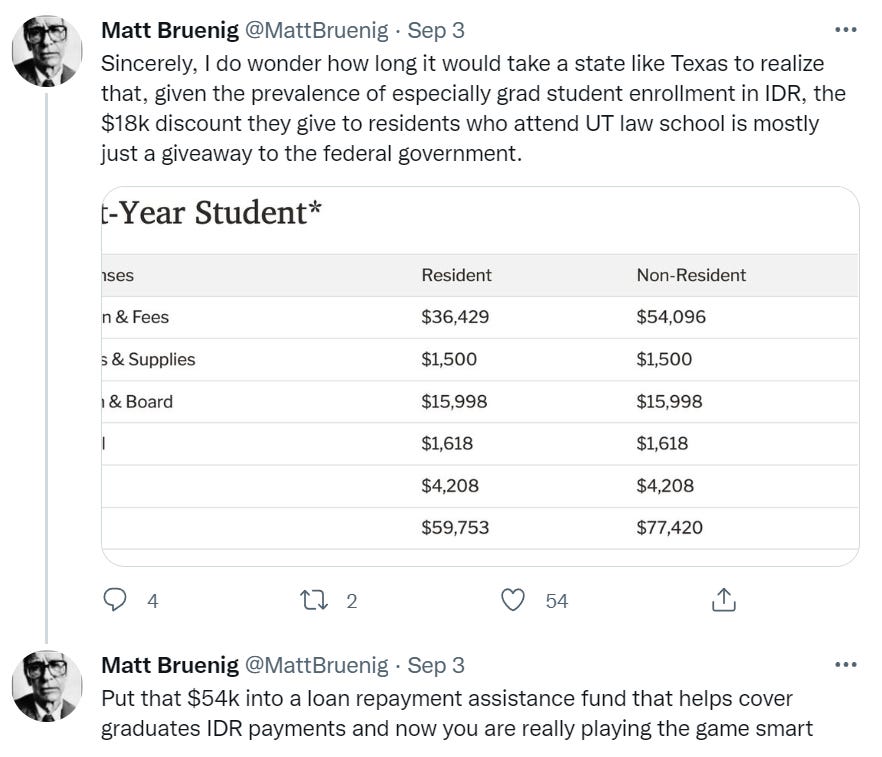
AMC is closing because it is unprofitable, no not that unprofitable AMC, the Atlanta Medical Center. Politicians including Senator Warnock are determined to stop this as he promises to do everything in his power. Alas, everything in his power seems so far to be sending a letter urging them to reconsider, which contains no financial incentives and insufficiently many memes.
America is a Rich Death Trap. One of two causes listed is a lack of primary care doctors due to medical school debt, which sounds a lot like what happens when one restricts supply (not enough residency slots, not allowing foreign doctors to practice, requiring medical degrees for way too many things) and subsidizes demand (health insurance and the idea that one does not pay for medical care). The other cause is lack of housing, no prizes for guessing what’s up with that one.
Thread claiming that what is happening to Warner Brothers, and to Hollywood in general with its lining up each studio’s content under its own streaming service, is because the Supreme Court got rid of our anti-trust defenses in the form of the Paramount Decrees. In this model WB is the new RKO, making terrible anti-creative decisions on the basis of morals, prioritizing taking tax deductions and generally being incredibly dumb.
I fail to understand how the core things going wrong relate to the Paramount Decrees, because I fail to see how the Decrees would do anything here. I do think this points to a diagnosis of the issue, where streaming services have replaced movie theaters which causes different dynamics and more of an oligopoly.
If one wanted to solve this with anti-trust action one would need new anti-trust action. In particular, one would likely need to be willing to do some form of ‘other streaming services have the right to get your content at a reasonable price’ so that anyone can do a streaming service the same way anyone could do a movie theater or a radio station. Which seems like a reasonable thing to propose at this point.
I have zero idea why she thinks Amazon shouldn’t have been allowed to buy MGM.
Finland moves to unify payments and payment baselines from various sources (UI, disability, parental leave) under a single system and for a constant amount. This makes sense, the reason you need your expenses paid doesn’t change the size of your expenses.
I do not know how bad things are going to get in Europe. I do know that they intend to restrict supply and subsidize demand. As will the UK.
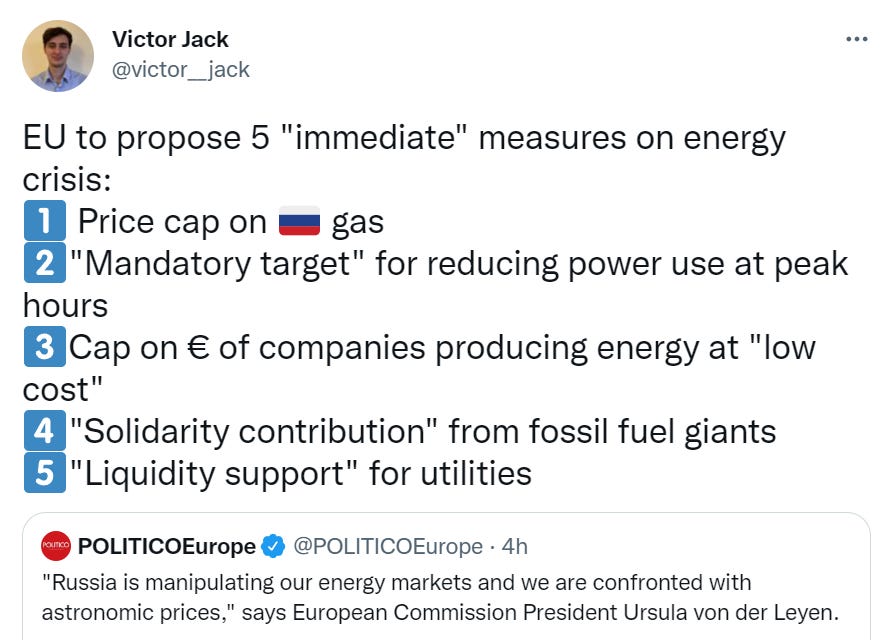

Gambling apps make it easy to gamble at any time, with minimal friction, legally, from your phone. This includes not only sports betting and cryptocurrency but also straightforward casino games like slots. Post predicts an oncoming crisis due to this lack of friction.
I have long had the opinion that sports betting is net good but that slots and other ‘pure’ and quick gambling is bad enough I’m willing to make an exception and say it should be illegal or at least require actively going to a true casino, especially after reading Addicted by Design.
Here, the solution seems obvious. Gambling addicts know they have a problem, so technological precommitment solves this. Require app stores to flag gambling apps as gambling in several categories – let’s say (1) skill games like sports betting and poker, (2) slots and other pure casino games, and then (3) kind-of-gambling things like crypto or options trading). Then require an account have the option to irreversibly lock itself out of any combination of these for any length of time, and require this if anyone if found to have a problem. Note that whether or not it does in practice this shouldn’t require a mandate, this should be handled by Apple and Google either way, it’s a feature.
Good News, Everyone
Baby formula shortages are slowly improving, head of FDA walks through various different measures of ‘in-stock rate’ selected to imply there was never a big issue.
Liz Truss gives other world leaders the personal touch.
Majority of American workers say they are fulfilling all required job tasks.
Details on California’s new YIMBY bills. My favorite detail is the battle between unions. One union wanted exclusive union labor on all construction projects, except that there literally aren’t enough union construction workers in California to do the work. So a different union wanted more construction to create more workers that could then be unionized. This is what led to the ‘choose your own adventure’ regulatory framework caused by passing both bills.
Number of people in prison is declining, largely due to California.

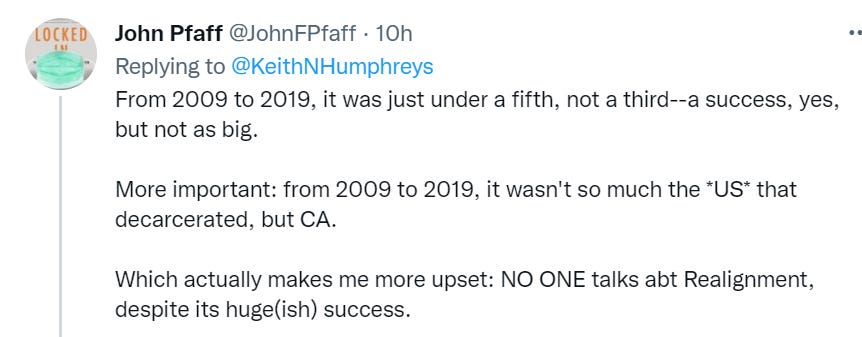
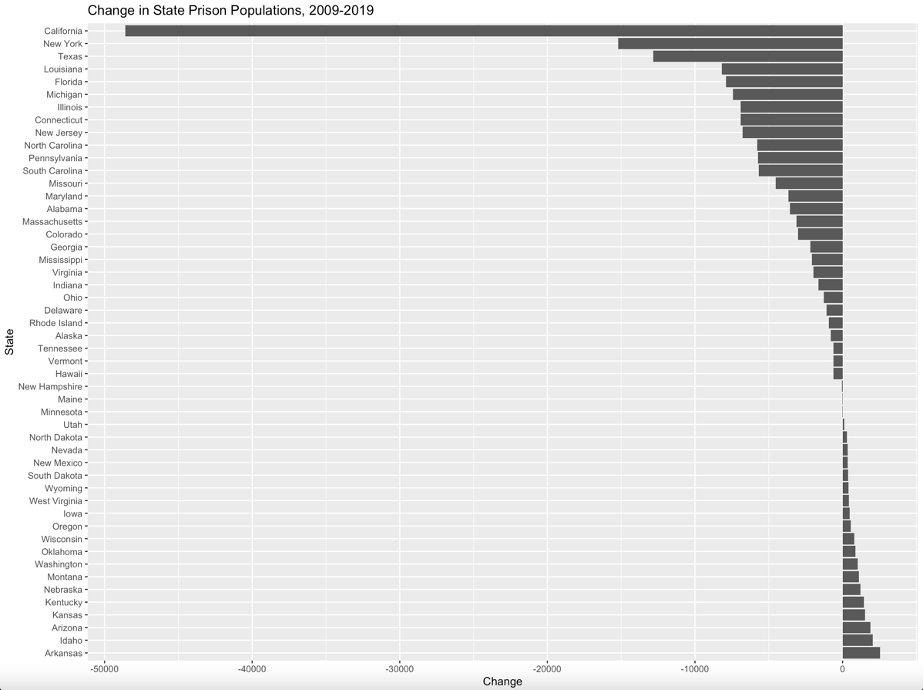

The sharp drop at the end is the pandemic, as ‘prosecutors were reluctant to put people in jail if they could avoid it’ which raises the question of why one isn’t reluctant to do so in normal times. Jail is quite destructive.
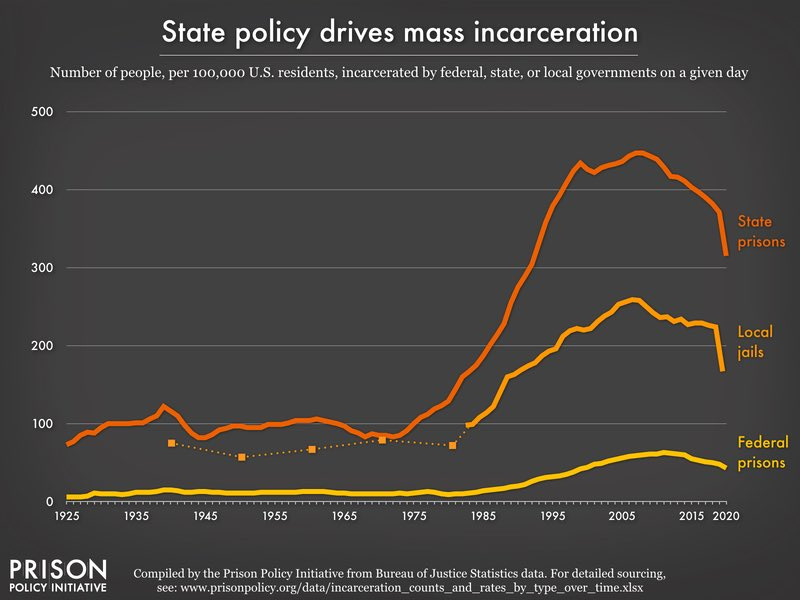
There are very reasonable complaints that California and in particular San Francisco kind of legalized crime on a small scale. One should not legalize (non-victimless) crime or universally decline to prosecute things like theft. I do not think this is directly the cause of much of the decrease in incarceration, as the jail times for such things tend to be short. Someone should still check.
California also pulled off something pretty cool, which was preventing blackouts by sending out a text asking people to conserve energy and they actually did it. Was good for about a 5% reduction.
Reinforcement Learning From Human Feedback
A correction: Last week I got too aggressively doomy about an AI paper. I was informed of this by a human named Eliezer Yudkowsky, who on reflection is correct, so I am learning. I am sorry and regret the error. We only want properly calibrated and accurate doom. Here is what I wrote.
New paper from Anthropic: AI training technique that works by teaching AI to lie in order to tell people what they want to hear proves best at telling people what they want to hear. Thinks this counts as safety.
Here is his correction:

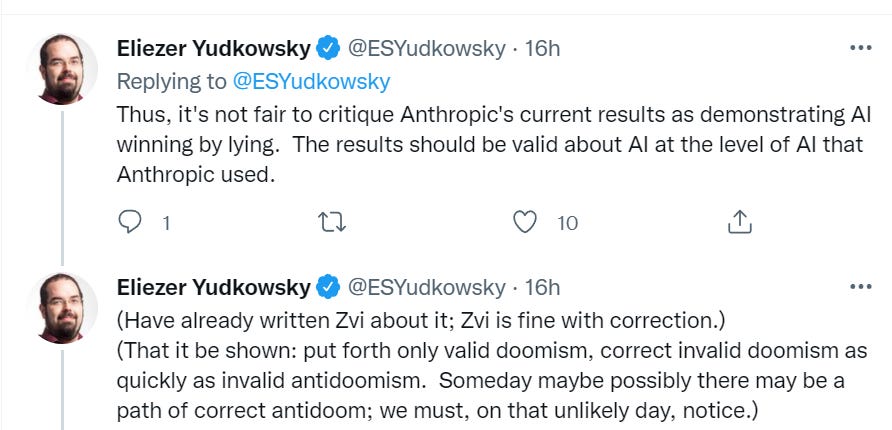
It is still bad news whenever the best performing technique is RLHF, because that will encourage further use of RLHF, which eventually does exactly the thing I described.
However, my claim went too far. The RLHF-trained version isn’t lying here to a greater extent than the other trained models except insofar as it is doing better on the underlying task. The underlying task isn’t exactly not lying, depending on one’s perspective, but the AI is indeed doing what we ask it to do.
9 comments
Comments sorted by top scores.
comment by trevor (TrevorWiesinger) · 2022-09-08T20:06:25.692Z · LW(p) · GW(p)
An environmentalist gets lunch: ‘Why being an effective environmentalist can often feel like being a bad one.”
The reason given here is that the things that feel environmentally friendly, and the things advocated for by environmentalists, tend to not be the things that help.
Effective Environmentalism is maximizing how good people feel about being environmentalists. Anything else would be, like, dry fog or some other impossible thing.
comment by ChristianKl · 2022-09-09T11:00:47.181Z · LW(p) · GW(p)
Environmentalism is not just about sacrificing to the Gods. If it was about sacrificing to the Gods, when people complain about their high gas prices we would tell them "It's a sacrifice to be made, you have to drive less".
People want to be able to think that living in a remote place and driving a lot is perfectly okay and better than living in a dense city.
Whenever I think about this I get angry at the subventions (via tax deductions) we pay in Germany to people who have long commutes.
comment by Rubix · 2022-09-09T10:44:08.596Z · LW(p) · GW(p)
Kidnapping by strangers, in particular, is vanishingly rare, and without that danger why in the world would you need to be 10 years old to play in your own front yard?
From talking to other parents, it seems like often they also have no sense of their kid's responsibility-when-unmonitored, because they've never tested it, and so aren't sure their nine-year-old wouldn't run in front of a car.
comment by tkpwaeub (gabriel-holmes) · 2022-09-08T17:24:13.905Z · LW(p) · GW(p)
I'm gonna throw this idea out there: might it be a good idea to stagger booster shots within a household? We never know for sure when the next surge will occur, but we do know that (1) immunity against infection wanes and (2) household transmission is a big factor during surges. Careful timing boosters within a household (or social bubble) might be a good way to take more control of what can be controlled.
Just spitballing, as they say.
Replies from: gabriel-holmes, Zian↑ comment by tkpwaeub (gabriel-holmes) · 2022-09-11T01:00:03.389Z · LW(p) · GW(p)
I found this:
https://journals.plos.org/plosone/article?id=10.1371/journal.pone.0263155
"Further investigating herd immunity thresholds for a range of values for R0 we find that for most parameter choices, EHR achieves herd immunity with fewer vaccinated individuals than the other presented strategies (and universally, dramatically earlier than age-based strategies). At the most extreme, assuming a 90% effective vaccine and R0 = 2, EHR achieves herd immunity at just 48% of the population vaccinated, compared to thresholds of 61% and 89% for random and eldest-first strategies. At 100% efficiency, the relative herd immunity thresholds are 44% and 55%, for the EHR and random strategies, respectively."
↑ comment by tkpwaeub (gabriel-holmes) · 2022-09-11T16:27:23.822Z · LW(p) · GW(p)
From the article, here's a description of the strategy:
As an example, consider a hypothetical community of 5 households labeled A through E, with 5 individuals in household A, 4 in household B, 3 in C, 2 in D, and 1 in E. This gives a total of 15 individuals, none of which are previously immune. Suppose that we only have the capacity to fully vaccinate 5 individuals. In line with the reasoning above, EHR gives the following vaccination strategy:
- The largest household by effective size is A, with 5 individuals. The first vaccine is therefore allocated to the eldest member of A.
- A and B are now tied in terms of effective size, with 4 susceptible individuals each. We therefore vaccinate one person each from both A and B.
- A, B, and C are now tied in terms of effective size, with 3 individuals each. With enough capacity left to vaccinate only two people, we therefore randomly choose two of the three households, and vaccinate one individual in each of the randomly chosen households.
↑ comment by Zian · 2022-09-09T04:08:00.216Z · LW(p) · GW(p)
Would the costs of figuring that out and implementing it exceed the expected benefits? Assuming that everyone in the household is already boosted with the monovalent version, it seems unlike for the costs to be worthwhile.
Replies from: gabriel-holmes↑ comment by tkpwaeub (gabriel-holmes) · 2022-09-09T08:27:22.698Z · LW(p) · GW(p)
I doubt it would cost very much. Epidemiologists have software they can use to model it. Moreover, an easy way to do controlled experiments would be dorm assignments on college campuses.
At any rate, my unabashedly Bayesian gut feeling is that it's obviously a good idea to do it. See above for my priors.
To the extent that this kind of thing is hard, I'd put it squarely in the "hard but worth it" bucket, along the lines of JFK's speech at Rice University. I'm calling for us to stop meekly accepting case surges as inevitable, and I don't think it's unreasonable to speculate that by leading with mass vaccination, we've unwittingly created a kind of "bang bang control system" with similar issues to overworked thermostats - a public health analog of metal fatigue, if you will.
comment by philh · 2022-09-12T01:19:49.226Z · LW(p) · GW(p)
Finland moves to unify payments and payment baselines from various sources (UI, disability, parental leave) under a single system and for a constant amount. This makes sense, the reason you need your expenses paid doesn’t change the size of your expenses.
Tweet's been deleted so maybe I misunderstand. It sounds like you're saying you expect an unemployed person, a disabled person and a recent parent to have similar expenses on average? I wouldn't expect that.